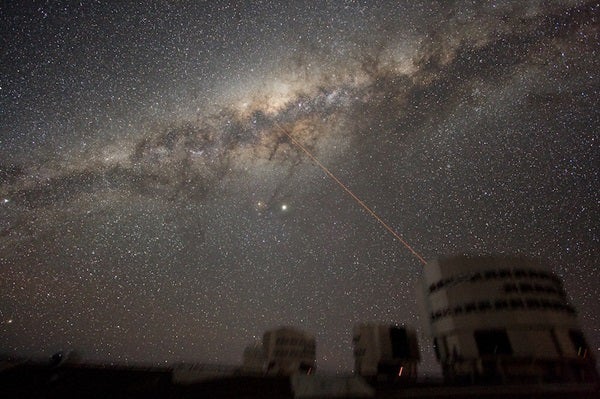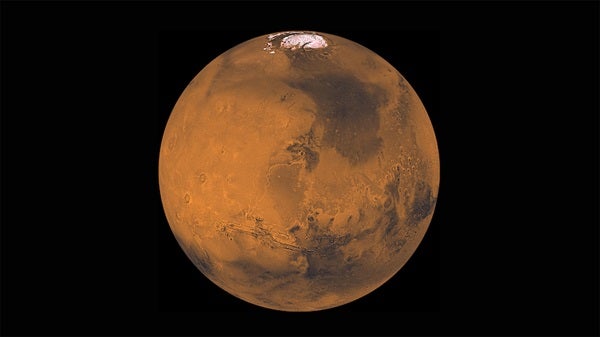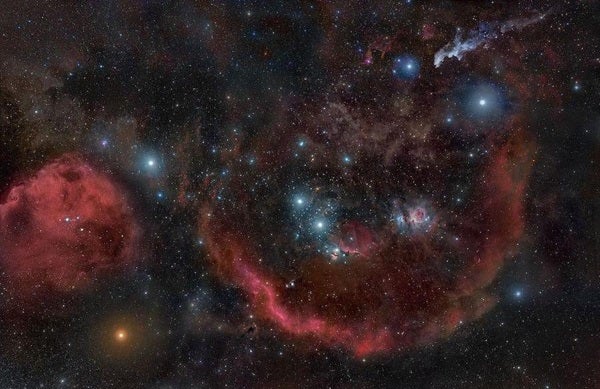The waning gibbous Moon rises in the east around 8 p.m. local daylight time. Wait about an hour for it to climb well clear of the horizon and you’ll see it perched just west of the Hyades star cluster in the constellation Taurus the Bull. Binoculars will deliver the best views of this pretty conjunction. If you keep watching throughout the night, you’ll see the Moon pass in front of the V-shaped Hyades.
Venus reaches inferior conjunction at 10 a.m. EDT. This position places the inner planet most nearly between Earth and the Sun (precisely 6° south-southwest of our star), so it is lost in the glare. But the brilliant world orbits the Sun quickly, and it will return to view before dawn in about 10 days.
Saturday, October 27
This evening provides skywatchers with one of their final chances to see Jupiter before it disappears in the Sun’s glow. Use binoculars to locate the giant planet some 6° above the southwestern horizon 30 minutes after sunset. Jupiter shines brightly at magnitude –1.7 and should be obvious if you have a clear and unobstructed horizon. As a bonus, you might also catch a glimpse of Mercury. The innermost planet lies 3.4° (about half a binocular field) below Jupiter. At magnitude –0.2, Mercury appears about one-quarter as bright as its companion.
Sunday, October 28
Look high in the southeast after darkness falls this week, and you should see autumn’s most conspicuous star group. The Great Square of Pegasus stands out in the evening sky at this time of year, though it appears balanced on one corner and looks more diamond-shaped. These four almost equally bright stars form the body of Pegasus the Winged Horse. The fainter stars that represent the rest of this constellation’s shape trail off to the square’s west.
Monday, October 29
Mars continues to put on a great show these October evenings. The Red Planet appears more than 30° above the southern horizon once darkness falls. The world shines at magnitude –0.7, significantly brighter than any star visible on October evenings, against the faint backdrop of Capricornus. A telescope reveals a disk that spans 12″ and shows several subtle surface features.
Uranus reached opposition and peak visibility one week ago, and it remains a tempting target all this week. The outer planet appears in the eastern sky after darkness falls and climbs highest in the south around midnight local daylight time. The magnitude 5.7 world lies in the southwestern corner of Aries, just over the border from Pisces, some 2.5° northeast of 4th-magnitude Omicron () Piscium. Although Uranus shines brightly enough to glimpse with the naked eye under a dark sky, use binoculars to locate it initially. A telescope reveals the planet’s blue-green disk, which spans 3.7″.
Wednesday, October 31
Last Quarter Moon occurs at 12:40 p.m. EDT. By the time it rises in North America shortly after midnight local daylight time, its phase will have waned to approximately 43 percent lit. Earth’s satellite lies near the border between Cancer the Crab and Leo the Lion.
The Moon reaches perigee, the closest point in its orbit around Earth, at 4:23 p.m. EDT. It then lies 230,034 miles (370,204 kilometers) away from us.
Thursday, November 1
The night sky’s most conspicuous harbinger of winter now rises in the east around 11 p.m. local daylight time. The constellation Orion the Hunter appears on its side as it rises, with ruddy Betelgeuse to the left of the three-star belt and blue-white Rigel to the belt’s right. As Orion climbs higher before dawn, the figure rotates so that Betelgeuse lies at the upper left and Rigel at the lower right of the constellation pattern.
Saturn remains a tempting target in the early evening sky. The ringed planet stands about 20° above the southwestern horizon an hour after sunset and remains on view until 9 p.m. local daylight time. Shining at magnitude 0.6, it appears more than a full magnitude brighter than any of the background stars in its host constellation, Sagittarius. Of course, the best views of Saturn come through a telescope, which reveals a 16″-diameter globe surrounded by a spectacular ring system that spans 36″ and tilts 26° to our line of sight.
Saturday, November 3
Although the calendar says November, the Summer Triangle of bright stars remains prominent in the early evening. Look overhead after darkness falls and you’ll spot Deneb, a conspicuous point of light despite being the faintest of the three luminaries. Brightest Vega lies west of Deneb and intermediate Altair appears to their south.
Sunday, November 4
Although Venus passed between the Sun and Earth just nine days ago, its rapid orbital motion brings it back into view quickly. This morning, the planet rises an hour before the Sun and climbs 5° high in the east-southeast 30 minutes before sunrise. Shining at magnitude –4.3, the brilliant world appears conspicuous against the twilight glow. When viewed through a telescope, Venus displays a 59″-diameter disk that is just 3 percent illuminated.
For those areas of the United States and Canada that observe daylight saving time, set your clocks back 1 hour this morning. The official switch occurs at 2 a.m. local daylight time, which becomes 1 a.m. local standard time. The switch means sunrise and sunset both arrive an hour earlier today than they did yesterday. So, at least by clock time, the latest sunrise of the year occurred yesterday morning.












